I – Muay Thai (kick boxing)
(lessons – using modals, definite and indefinite articles, & measurement words + reading for understanding- I level)
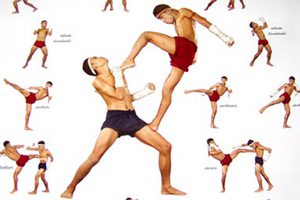
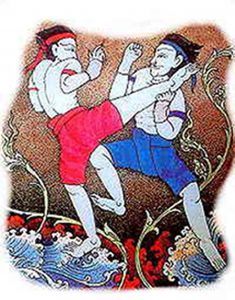
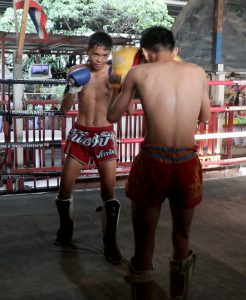
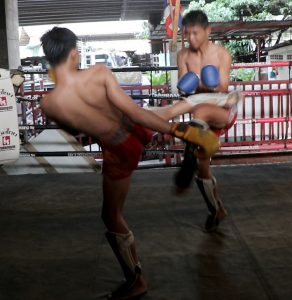
Muay Thai made its first appearance in Thailand 700 years ago. It is the “art of eight limbs” martial arts because one needs to use the fist, elbows, knees and shins apart from the four limbs of the body to defeat an opponent. Muay Thai or Thai boxing is the national sport and cultural martial art of Thailand. It was developed several hundreds of years ago as a form of close-combat that utilizes the entire body as a weapon using eight limbs. The word “Muay” is actually derived from the word “Mavya” in sanskrit meaning “to bind together” or “to make things united”. In muay Thai the body (1) mimics as a weapon of war. In combat or in competetion the hands (2) are first used like a sword and dagger. When the opponent attacks, the shins (3) and forearms (4) are used as a shield against any blows. To attack and to counter the attacks of his opponent, the muay Thai fighter uses his legs (5) and knees (6) that become the axe and staff. For that reason, the whole body (7) of the muay Thai fighter operates as one unit. Both of his knees and elbows (8) are used as a means to search and test his opponent and eventually to find an opening while grappling and trying to spin the enemy to the ground for the kill or,in competition, a takedown. This is how muay Thai fighters become great champions in this martial arts of Thailand.
When the two muay Thai fighters face off, the match is mediated by a referee who makes sure that there is no cheating, unacceptable kicks or hits that are not permitted in the contest. The match is divided into five (5) rounds each round lasting three (3) minutes. The match ends when one of the two fighters is deemed incapable of continuing by the referee, breaks a rule or is disqualified. A competitor can also resign by throwing in a towel or be pronounced the winner or loser based on the scoring of the judges at the end of the contest.
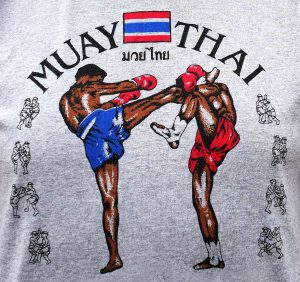
Because it is the national sport and cultural martial art of Thailand, many young children are drawn into the martial art at a very young age (7 or 8 years old) to become muay Thai fighters. Often, it is the child’s parents who make the decision for their child to become a fighter. The life of a muay Thai fighter, especially as a child, is never easy. On top of attending school (if he is even given the opportunity to attend school), he has to adhere to a strict training schedule and supplement it with strength and conditioning exercises.
In Thailand when muay Thai fighters become very good at their skill, they will earn a lot of money which much is more than the average Thai worker who gets 10,000 Baht per month or $305 a month or $3660 a year. A muay Thai or kickboxer can make over $31,000 a year which is more than enough money to feed their family members and live a very good life in Thailand. Becoming a muay Thai fighter has been a ticket out of poverty for many young kids. Besides the money, children who become muay Thai fighters are admired in school and become very popular. Once they decide to become fighters, they must follow a strict training schedule. The parents of children who train to be muay Thai fighters strongly believe that the training can help their children avoid trouble, drugs, and boredome, and become stronger physically, mentally and socially. Ultimately, the children improve their confidence and self-esteem as a person. It is not uncommon to find 15 – 20,000 young children in rural countryside all over Thailand training to become Muay Thai fighters.
The training of young muay Thai fighter is very rigorous. Trainees must get up early in the morning to begin their regimen. First, they have to do jump rope to start the day and then they must run 3 – 5 miles around the neighborhood and different areas of their rural village to warm up. This takes about two or three hours. After running they would do a combination of wind sprints, running up stairs, long jumps and other callisthenic activities. Then the trainees would do some shadow boxing and light bag work.
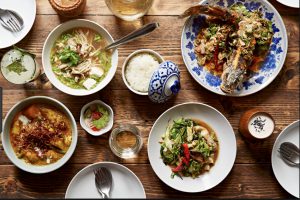
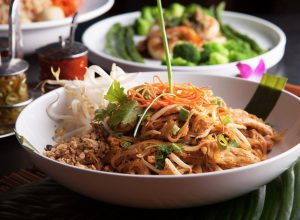
Then they eat breakfast from 7 – 10:00 a.m. Their breakfast is a heavy meal. Many times it becomes like lunch and dinner combined because they must train again for another 5 to 7 hours in the afternoon and evening. They usually eat food like a plate of khao man gai(chicken and rice) , a bowl of gra pao(any kind of meat that is stir fried with Thai basil) or a bowl of khao soi(a soup-like dish with a mix of deep-fried crispy egg noodles and a serving of boiled egg noodles, several servings of pickled mustard greens, a cup of shallots, a tablespoon of ground chillies fried in oil and a big piece of meat in curry-like sauce containing coconut milk). Muay Thai fighters’ diet can change according to their region. In poor regions the diet could be a bowl of fish soup, a plate of eggs, boiled vegetables, and a bowl of som tam salad (salad made of shredded green papaya, several servings of chopped long beans, a tablespoon of garlic, a cup of tomatoes, a cup of green chillis, a half pint of lime juice and a dash of sugar with fish sauce). To hydrate they must drink 4 – 6 bottles of water every day.
In the afternoon they continue their round of training. The young muay Thai trainees must learn how to use both hands to punch like boxers using hanging punching bags and a pair of boxing gloves provided by their trainers. . Most of their training must involve their legs, knees, and feet to strike an opponent. To strengthen these parts of the body, they must use a punching bag to work on these techniques. Often times the trainer must use padded hand, elbow or arm guards while the trainee strikes at them in different positions and angles. In the afternoon the trainees must do a combination Jump Rope, Shadow Boxing and hitting Thai pads with the trainer for 5 rounds. Each day they need to spar with other trainees for 5 – 10 rounds and later they need to condition their abdominals using different varieties and weights of medicine balls which they move back and forth while contorting their bodies in different kinds of positions and angles.


From 12:00-5:00pm they need to workout doing different sets of squats, bench press, dead lifts, military presses, pull ups, push ups and various core exercises to strengthen the abdominal. Lunch can vary depending on their schedule of the day, but they need to take an afternoon nap to rest their bodies. After the nap, the trainees have to do more strength workouts combining military presses, squats, bench presses, deadlifts, and more pull ups, push ups and various core exercises to strengthen the abdominal. Generally, the exercises must be repeated over and over so that the exercises become a routine for the trainees. Usually, the trainees trade off doing the exercises. That way not everyone is doing the same thing at once.

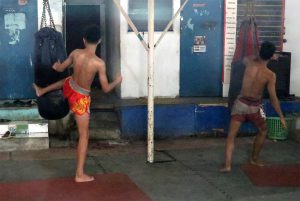
Muay Thai fighters must spend countless hours conditioning their bodies to withstand the tremendous strikes their opponent will unleash upon them. In addition to being mentally and physically tough, Thai fighters need to be extremely athletic. Muay Thai requires the athlete to acquire a large range of athletic qualities like agility, speed, power, strength, coordination, balance, timing, and visual acuity. In general, fighters must train 2-3 times per day for periods of up to 2-3 hours per session. Due to the lack of on- and off-seasons, fighters need to train year-round if they want to have a successful career and get the big title fights. Training starts at 5am and could last until 8pm.
Foreigners or visitors who come to visit Thailand have the opinion that muay Thai fighting impedes the children’s education. Outsider say it can expose children to bad people who gamble and break the law. Others say it encourages parents to rely on their child’s income when the child starts making good money. Their primary argument is that it violates the rights of children.
However, Thai people say muay Thai provides children a process of acculturation by teaching them the history of their country and the value of muay Thai fighting. They also say that it teaches them values of perseverance and self-reliance. In many cases young children who become successful in muay Thai martial arts earn a lot of money which is far more that the salary of a rice farmer in Thailand. It is a fact that many of the young muay Thai fighters come from impoverished rural families and their success as muay Thai fighters help them to provide the income they need to survive and live a better life away from their poor environment. For the men, muay Thai is a way to show their masculine dignity. Most foreigners or visitors don’t understand the value of muay Thai fighting because to them it is brutal and devastating. But, for the Thai people, muay Thai is the core symbol of diginity and pride of the Thai people.
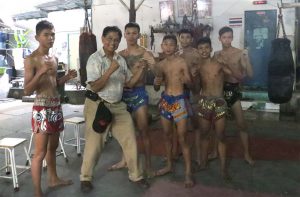
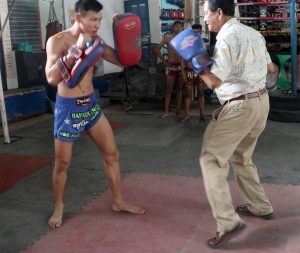
When I was in Bangkok, I was very fortunate to have seen and witnessed how hard muay Thai fighters train to become skilled at their craft. During my visit, I got to see how and when they use their legs and feet to make a strike at their opponent. I was even given the opportunity to train with the fighters. They often use punching bags to strengthen their leg and feet muscles and do repetitious kicks on the bags to acquire agility, strength and speed. They trade off from training on the punching bags, doing abdominal exercises using medicine balls, jump rope and later sparring on the ring with their colleagues to simulate combat on the ring. Their focus, demeanor and endurance were always spot on as they trained meticulously and methodically. What impressed me the most was their camaraderie, mental and social acuteness, and their determination to become good muay Thai fighters. No doubt, as trainees in this art of muay Thai fighting, they are very proud and feel dignified to be Thai fighters in this marital arts of muay Thai fighting.
A. Answer the following questions based on the reading.
B. Modals
1. Have to – expresses responsibility or necessity.
Example: Muay Thai fighter have to wake up early in the morning to start their training.
2. Must – shows personal obligations
Example: Muay Thai fighters must eat the proper diet and exercise every day to be healthy and strong.
3. Need to – indicates that it is important for someone
Example: Muay Thai fighter need to dedicate their time to training and following their daily schedule diligently and faithfully.
In many situations “have to, must and need to” are used interchangeably depending on how the person feels or thinks about the situation.
Example 1: ESL students must (or have to or need to) attend class often to improve their skills in English.
Example 2: People must (or have to or need to) work in order to earn money and provide for their family.
Example 3: People must (or have to or need to) eat the right kind of food to be healthy and strong.
C. Count and non-count nouns
- Count nous are things we can count.They have a singular and plural form.
Example: apple – apples / car – cars / candy – candies / watch – watches
Example sentences: I eat an apple every morning. / My daughter eats two apples every day.
- Non-count nouns are things we cannot count.
Example: Sugar / milk / music / homework
Example sentences: I love sugar in my tea. / Music helps me to relax. / There is no homework tonight.
- Non-count nouns do not have a plural form. Thus, they cannot end in “s.”
(You cannot say: “People love sugars or I have homeworks tonight.”
D. Using a/an with count nouns
- Use “a or an” before singular count nouns or before an adjective + singular count noun. Example: a house / an old house (plural – houses)
- Don’t use “a or an” with plural nouns. Example: Our friend sells houses. (not – Our friend sells a houses.)
- Do not use “a or an” with non-count nouns. Example: We need help in our ESL class. (not – We need a help in the ESL class.)
- Use “a” before consonant nouns. Use “an” before vowel sounds. Example: Children like to eat a happy meal. Parents love an honest child.
E. Exercise on count and non-count nouns
F. More practice on count and non-count nouns
G. Non-count nouns can be put into categories.
Here are some categories:
a. (Food) – bread / meat / pasta / salt / sugar / yogurt / fish / chicken
b. (liquids) – oil / water / soup / gasoline / coffee
c. (Activities) – tennis / golf / yoga / zumba / boxing
d. (Abstract nouns) – courage/ luck / time / fun / advice
e. (diseases and health condition) – arthritis / cancer / obesity
f. (elements and gases) – gold / oxygen / hydrogen
g. (natural phenomena) – electricity / rain / thunder
h. (particles) – sand, sugar, pepper
i. (Other types of non-count nouns) – weather / time / jewelry / homework /lightening / luggage / money / smog / sight / air
H. Exercise on non-count nouns
Write the correct non-count word based on the following sentences.
Weather / time / luggage / traffic / money / homework / furniture / fruit / clothing
I. More practice on non-count nouns.
E. Measurement words
- Measurement words like “a bag, a jar , a teaspoon, etc.” are usually followed with “of.”
Thus, we can say “a bag of potatoes, a jar of honey, or a teaspoon of sugar.”
- A measurement word + of is always followed by a plural count noun.
Examples: a bag of potatoes / a box of cookies / a pound of bananas
- However, non-count nouns do not have a plural after a measurement word + of
Examples: a can of oil / a bottle of water / a loaf of bread / a bar of soap / a jar of honey.
Some common measurement words
(containers) – a carton of milk / a box of cookies / a can of soup / a bottle of water
(portions) – a cup of soup / a piece of meat / a slice of cheese / a glass of milk
(specific measurements) – a litter of oil / a kilogram of pork / a gallon of gas / a cup of flour
(other measurements) – a stick of butter / a tube of toothpaste / a head of lettuce / a bunch of grapes / a bar of soap
